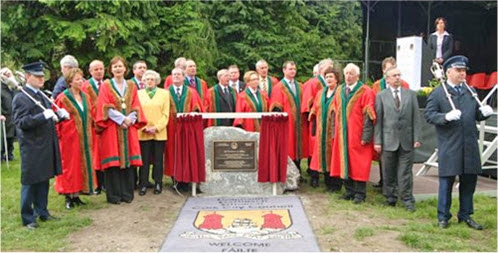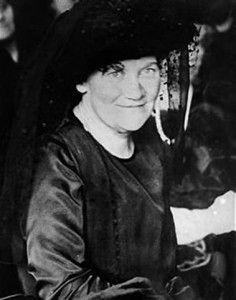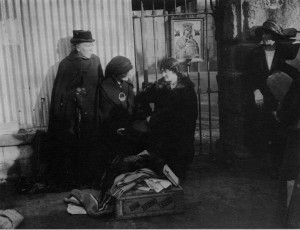Cork, city and county, was one of the most prominent theatres of the Irish revolution between 1912 and 1922. Cumann na mBan made a central contribution to the major political events and developments of the day, including in the areas of republicanism and the campaign for universal suffrage for women. Mary MacSwiney, for instance, who was involved in both campaigns, was elected to Dáil Éireann as a Sinn Féin representative for Cork City in 1918, 1921 and 1922.
For more information on the locations involved, please see below.
City Hall
Margaret Lucey of 4 Upper Janemount, Sunday’s Well was Treasurer of Cumann na mBan in Cork. Lucey was present when the first branch of Cumann na mBan was founded in Cork City Hall in 1914. She later regularly attended meeetings in the Volunteer Hall in Sheare’s Street.
Margaret Lucey's witness statement to the Bureau of Military History addresses the activities of Cumann na mBan, Cork city, 1914-21, and includes a diary of events at Brixton Prison by Áine MacSwiney, sister of Terence MacSwiney. Below is the cover sheet of the witness statement. Click here to see the full text of the statement.
Queen Street
Peg Duggan, 49 Thomas Davis Street, Cork, was captain of the Tomás Ceannt Branch of Cumann na mBan in Cork and Treasurer of the Prisoners’ Dependents’ Fund, Cork. Along with her sisters, Peg joined the South Parish branch of the Gaelic League in 1912 and joined Cumann na mBan in 1913. Both orgainsations met in Queen Street. The Gaelic League met in An Grianáin while Cumann na mBan met in a hall known as An Dún. Cumann na mBan members took part in rifle practice in the Volunteer Hall in Sheare Street, where they met most regularly and had weekly parades.
Peg Duggan's witness statement to the Bureau of Military History describes Cumann na mBan activities in Cork city during the period 1913 to 1921. Below is the cover sheet of the witness statement. Click here to see the full statement.

Lord Mayor Cllr. Deirdre Clune (front row, third from left) photographed with members of Cork City Council; City Manager Joe Gavin; Siobhán O'Connor, whose close relatives were active in Cumann na mBan; and mace bearers Pat Russell and John Kenneally at the unveiling of a plaque to name the Riverside Walk Slí Chumann na mBan on Monday, 17 April 2006, on the occasion of the 90th anniversary of the Easter Rising 1916.
Lord Mayor Speech, Slí Chumann na mBan
Speech by Lord Mayor of Cork Cllr Deirdre Clune at the unveiling of the plaque to name the Riverside Walk Slí Chumann na mBan on Monday, 17 April 2006 on the occasion of the 90th anniversary of the Easter Rising 1916
Fellow Councillors, members of the Armed Forces, Teachtaí Dála, Distinguished Guests, Ladies and Gentlemen.
It is a great privilege for me as a local representative, as one who has the honour of representing this great city as Lord Mayor and as a woman, to address you here this afternoon at the naming of this Riverside Walk as Slí Chumann na mBan.
Murach an thréanobair a rinne baill de Chumann na mBan I dtosach an fichú chead tá gach seans go dtagadh an votá do mnáibh na hEireann I bhfad níos deánaí na mar a tháininig, ach tiocfaidh me ar ais chuige san níos deanaí.
You will hear much, and may already have heard a great deal over the last few days, about the Easter Rising of 1916, how representative of the will of the people it was (or wasn’t), whether we should celebrate it and how, but I am relatively certain that in all the commemoration, reflection and even perhaps revisionism, that the role played by Cumann na mBan will have played a subsidiary role and may even have gone unrecognised and under- reported. It is fitting therefore that we take this opportunity to commemorate the central contribution made by Cumann na mBan not just in the events of 1916 and the subsequent move towards independence, but in the largely unreported contribution made by its members towards universal suffrage for women.
I don’t propose here this afternoon to give a lesson in the origin and history of the organisation, there are those present far better placed to give such an account, but I will, with your indulgence, outline the more salient points which make them relevant and worthy of commemoration 92 years after their foundation and 90 years after the insurrection which subsequently led to the creation of the Republic.
Cumann na mBan, the ‘League of Women’, was formed in 1914 as an auxiliary corps, to complement the Irish Volunteer Force (IVF). Its recruits were from diverse backgrounds, mainly white-collar workers and professional women, but with a significant proportion also from the working class.
On 23 April 1916, when the IRB Military Council finalised arrangements for the Easter Rising, it integrated Cumann na mBan, along with the Volunteers and Citizen Army, into the ‘Army of the Irish Republic’; Pearse was appointed overall Commandant-General and Connolly as Commandant-General of the Dublin Division. However, in anticipation of fierce hand-to-hand fighting, some of the rebel leaders - De Valera at Boland’s Bakery and Eamon Ceannt at South Dublin Union - did not permit Cumann na mBan to occupy posts alongside their garrisons.
But elsewhere the organisation played a vital role. They worked at First Aid posts tending wounded, prepared and delivered meals, gathered intelligence on scouting expeditions, carried despatches and transferred arms from dumps across the city to insurgent strongholds. At the Four Courts they helped to organise the evacuation of buildings at the time of surrender and to destroy incriminating papers.
The occupation of the Four Courts by the anti–Treaty IRA — "Easter week in reverse" as Desmond Greaves called it — echoed Easter week in more ways than one. Women like Maire Comerford carried dispatches under fire and Linda Kearns risked her life tending the wounded.
Cork, as one might expect from a county with a sobriquet “ The Rebel County” also had its part to play. Mary MacSwiney, sister of Terence MacSwiney, in whose footsteps I am honoured to follow as Lord Mayor, was a founder member of Cumann na mBan in 1914 and President of the Cork Branch. She was interned after the 1916 Rising, as a result of which she lost her job as a teacher. In 1917 she and her sister Annie founded St. Ita's School for girls in Cork City where all subjects were taught through the medium of Irish.
MacSwiney joined Sinn Féin in 1917 and in 1918 she was elected to the First Dáil for Cork. MacSwiney was appointed to the Cabinet of the Second Dáil in 1922 and was twice imprisoned during the Civil War, undergoing a twenty-one day hunger-strike in Mountjoy Gaol and a twenty-four day hunger-strike in Kilmainham Gaol.
After the Civil War MacSwiney remained active in Cumann na mBan and in republican politics. In 1933 she, together with Albinia Broderick, founded Mná Poblachta to rival Cumann na mBan which MacSwiney believed was moving too far to the left. In 1934 she was a member of the short lived Republican Congress.
The vote against the Treaty may have been lost in the Dáil, but the women scored an important victory in securing the franchise for all women over twenty–one. The vote had been granted in 1918 only to women aged thirty or over. Thus Irish women were fully franchised from 1921 onwards; women in Britain had to wait until 1928 before they got the vote on equal terms with men.
If women tended to fill gaps left by men’s absence, or to do the work men would not do, Ireland’s fight for freedom gave Irish feminists an arena to continue to operate in which prevented the feminist movement from fizzling out once the vote had been won. Often engaged on several fronts at once, women played a vital role in bringing together the different strands of the revolutionary movement: the military, political, feminist and socialist causes were thus integrated. Much had been achieved. The most progressive republican men had on the whole been ready to treat women as comrades and to accept them as equals.
Tréasláiom dos na mnáibh uile a ndearna an obair sin ar ár san agus a chabhraidh agus a chudigh le bunú na Poblachta. Tá sé thar am go mbronnfar an onór seo oththu.
In a time where word “Republican” has tended to have a more negative connotation, it is fit and proper that we remember that the original idea of a Republic, PLATO’s definition and that followed in spirit by the women of Cumann na mBan, is something, through familiarity we have all too often taken for granted. In honouring the women of Cumann na mBan here today with this dedication we remember the sacrifice made on our behalf by those who have gone before us and the debt of gratitude we owe them.
Go raibh míle maith agaibh,
Lord Mayor of Cork, Cllr. Deirdre Clune

Mary MacSwiney (Máire Nic Suibhne) was born in London on 27 March 1872 to an Irish father and English mother. The family returned to Cork when she was six and she was educated at St. Angela’s Ursuline convent school. She obtained a teaching diploma at Cambridge University and taught at schools in England before returning to Cork on the death of her mother in 1904 to care for younger members of the family. She took up a teaching post in St. Angela’s.
Mary MacSwiney attended the first meeting of the Munster Women’s Franchise League and became a committee member. She also joined the Gaelic League and Inghinidhe na hÉireann. She was a founder member of Cumann na mBan in Cork in 1914 and became a national vice-president of the organisation. She was arrested and imprisoned after the Easter Rising and dismissed from her job at the Ursuline.
Upon her release from prison, Mary MacSwiney established, along with her sister Annie, Scoil Íte, which was influenced by Patrick Pearse’s St. Enda’s. Her brother Terence, Sinn Féin Lord Mayor of Cork, died on hunger strike in October 1920. Along with another brother, Seán, in another Cork constituency, she was elected to the Dáil in 1921. She went to Washington to give evidence before the American Commission on conditions in Ireland. She conducted a tour of America with Terence’s widow, Muriel (Murphy), and was the first woman to be granted the freedom of New York City. She virulently opposed the Anglo-Irish Treaty and was interned during and after the Civil War, twice going on hunger strike. Annie MacSwiney also went on hunger strike. Mary retained her seat at the 1923 general election but, as per Sinn Féin policy, refused to enter the Dáil. (1)
(1) Maria Luddy, ‘MacSwiney, Mary Margaret (1872-1942)’, Oxford Dictionary of National Biography (Oxford, 2004); Charlotte H. Fallon, Soul of fire: a biography of Mary MacSwiney (Cork, 1986); Cal McCarthy, Cumann na mBan and the Irish Revolution (Cork, 2007).

Scoil Íte
Annie MacSwiney was a member of Cumann na mBan in Cork city. Together with her sister Mary she founded and managed Scoil Íte. The school was modelled on Patrick Pearse’s Scoil Éanna and emphasised Irish history, langugae and culture. In 1954 Scoil Íte amalgamated with nearby Scoil Mhuire and took that name. The building at 3 Belgrave Place, Wellington Road, which housed Scoil Íte, is now occupied by Sheila’s Hostel. Scoil Mhuire is still operating at Sidney Place, Wellington Road. Annie MacSwiney’s diary of her brother Terence’s hunger strike in Brixton Prison in England is reproduced in Margaret Lucey’s Witness Statement, a copy of which is available here.
Bandon
Mount Pleasant, Bandon
Anna Hurley, of Laragh, Bandon was president of the Cumann na mBan branch in Mount Pleasant, Bandon. Her witness statement to the Bureau of Military History details Cumann na mBan activities in the area during the War of Independence.
South Bandon
Mary Walsh of Killountain, Bandon was a Cumann na mBan captain in the area south of Bandon between 1917 and 1921. Her witness statement to the Bureau of Military History recorded her memories of events in Kilbrittain, Timoleague, Barryroe, Ballinspittle and the surrounding area during that period after the Easter Rising and throughout the War of Independence.